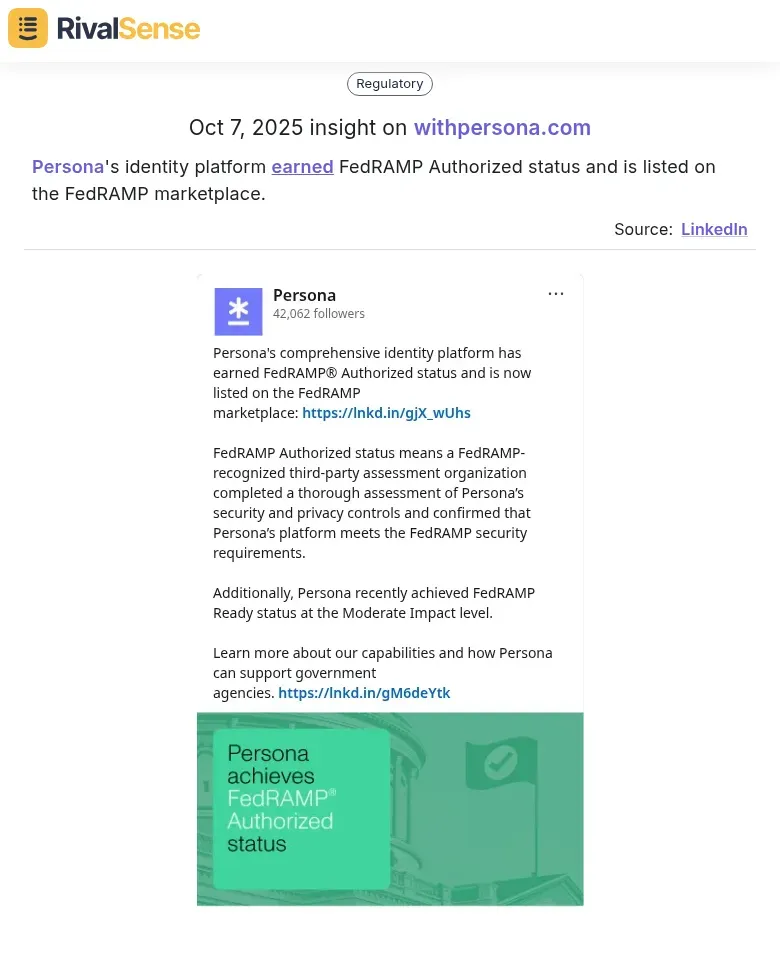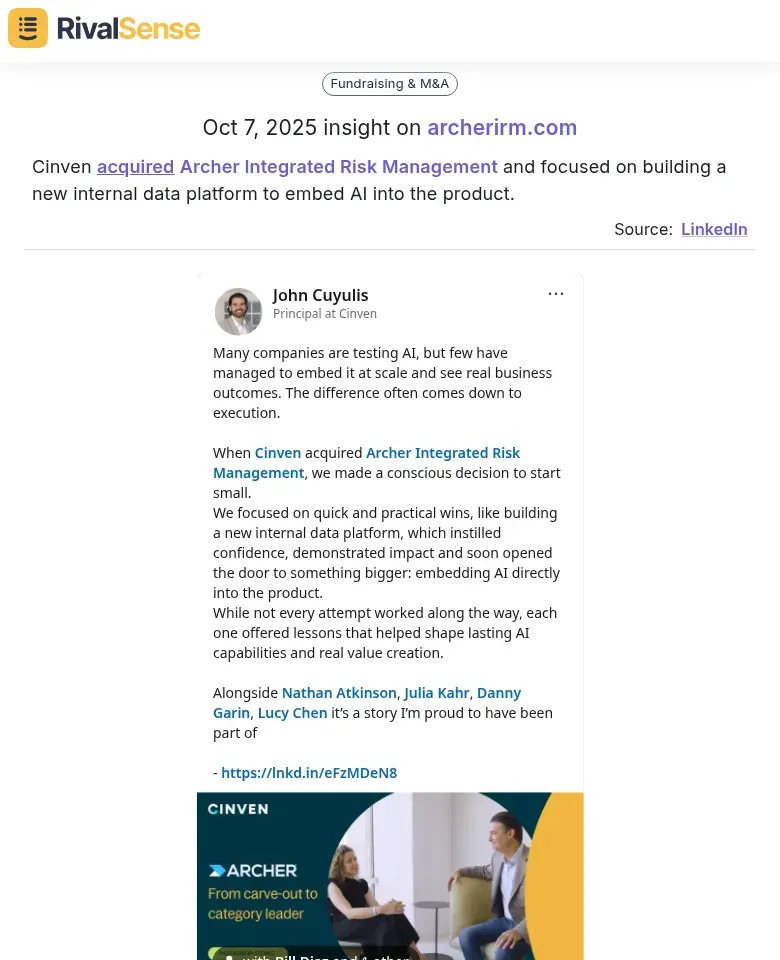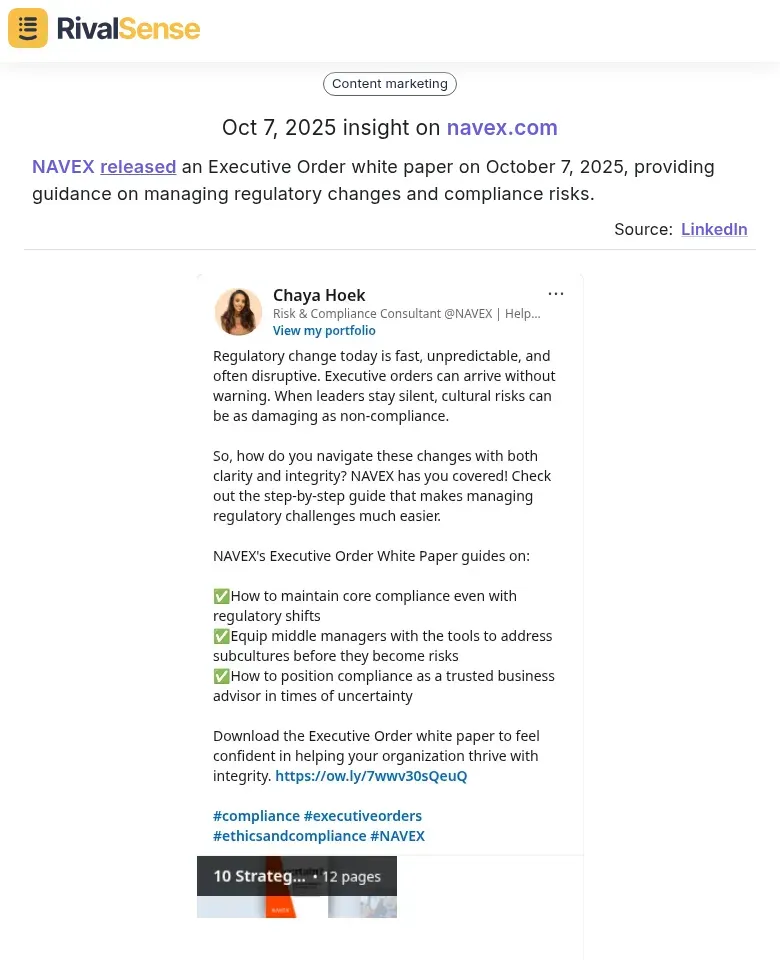LinkedIn Competitor Analysis: Uncover Target Audience Insights
LinkedIn competitor analysis transforms strategic decision-making by revealing how rivals engage their audience, identify market gaps, and position their brand. Unlike traditional methods, LinkedIn offers real-time insights into competitor content, follower growth, and engagement metrics—key indicators of audience preferences. For example, tracking a competitor's high-performing posts can uncover untapped topics or formats that resonate with your shared target audience. Benefits include refining your content strategy, anticipating market trends, and avoiding costly missteps.
🔍 Practical steps:
- Identify 3-5 key competitors and follow their LinkedIn pages.
- Use tools like RivalSense to monitor their post frequency, engagement rates, and audience demographics.
- Analyze top-performing content for common themes (e.g., case studies, industry news).
- Note gaps—if competitors overlook a niche topic, it's your opportunity.
💡 Tip: Focus on comments and shares to gauge audience sentiment and unmet needs. By leveraging these insights, you can tailor your messaging, boost engagement, and stay ahead in a competitive landscape.
Analyzing Competitor Product and Service Updates
Tracking competitor product and service updates provides crucial insights into their strategic direction and market positioning. Monitoring certifications and enhancements can reveal shifts in industry standards and customer expectations. For instance, when a competitor achieves a significant certification like FedRAMP Authorized status, it signals a focus on security and compliance, which is vital for targeting enterprise clients who prioritize data protection.

Example: Persona's identity platform earning FedRAMP Authorized status and listing on the FedRAMP marketplace. This type of insight is valuable because it highlights compliance milestones that can influence buyer decisions and help you align your product roadmap with evolving regulatory demands.
📋 Checklist for monitoring product updates:
- Monthly review competitor blogs, webinars, and LinkedIn posts.
- Note new integrations, certifications, or feature rollouts.
- Compare with your own roadmap to identify gaps and opportunities.
- Set up alerts for keywords like "new feature" or "certification" to stay proactive.
Monitoring Competitor Acquisitions and Strategic Moves
Keeping an eye on competitor acquisitions and strategic moves uncovers their expansion plans and technological investments. These actions often indicate market trends, such as a push towards AI integration or entry into new sectors, allowing you to anticipate industry shifts. For example, when a competitor acquires a company focused on AI, it may signal a growing demand for automation and predictive analytics in your niche.

Example: Cinven acquiring Archer Integrated Risk Management and building a new internal data platform to embed AI into the product. This insight is valuable as it reveals how competitors are leveraging acquisitions to enhance their offerings, helping you assess whether to develop similar capabilities or differentiate your strategy.
🚀 Practical steps:
- Track acquisition announcements via news alerts and industry reports.
- Analyze the acquired company's technology for AI, automation, or integrations.
- Assess how the move expands the competitor's ecosystem and addresses customer needs.
- Use these insights to refine your own strategic initiatives and maintain agility.
Tracking Competitor Content and Thought Leadership
Observing competitor content and thought leadership efforts helps you understand how they build authority and address market needs. By analyzing their white papers, reports, and webinars, you can identify recurring themes and timing strategies that resonate with your target audience. This approach allows you to position your brand as a timely expert and capitalize on emerging topics.

Example: NAVEX releasing an Executive Order white paper on October 7, 2025, providing guidance on managing regulatory changes and compliance risks. This type of insight is valuable because it shows how competitors respond to regulatory shifts, enabling you to time your content to address similar issues and establish thought leadership.
📅 Checklist for content tracking:
- Audit competitor content monthly and map themes to audience pain points.
- Monitor industry news and align your releases with current events.
- Use LinkedIn analytics to identify high-engagement formats and topics.
- Emulate successful strategies without copying to maintain originality.
Extracting Target Audience Insights from Competitor Activities
LinkedIn competitor analysis is a powerful way to extract deep audience insights by examining engagement patterns and content preferences. Correlating competitor activities with metrics like likes, shares, and comments can reveal what your shared audience values most, from proof-driven case studies to thought-provoking industry insights. This data helps refine buyer personas and anticipate evolving needs.
🎯 Practical steps:
- Monitor top competitors' LinkedIn activity weekly and map engagement to content themes.
- Analyze comments for recurring questions and unaddressed pain points.
- Update buyer personas based on job titles and sectors that engage most.
- Test tailored messaging in your campaigns to preempt competitor moves.
💡 Tip: If competitors target specific industries with compliance content, adapt your approach to address those regulatory concerns directly, ensuring your messaging resonates with decision-makers.
Implementing a Proactive Competitor Tracking Strategy
Developing a proactive competitor tracking strategy on LinkedIn ensures you stay agile and responsive to market changes. By systematically monitoring rivals' activities, you can integrate real-time insights into your business decisions, from refining product offerings to enhancing marketing campaigns. This approach mitigates risks and sharpens your competitive edge through continuous learning and adaptation.
📊 Best practices:
- Create a dedicated spreadsheet listing key competitors, their LinkedIn pages, and executives.
- Set up Google Alerts for competitor names and track job postings for expansion clues.
- Hold monthly competitive intelligence reviews to assess market gaps and trends.
- Leverage tools like RivalSense to automate tracking of posts, engagement, and growth metrics.
✅ Checklist for effective tracking:
- [ ] Monitor competitor job postings for strategic hints.
- [ ] Analyze content themes for audience targeting insights.
- [ ] Track executive moves and partnership announcements.
- [ ] Benchmark your LinkedIn performance against competitors to spot opportunities.
Ready to Elevate Your Competitor Analysis?
Implementing a robust LinkedIn competitor analysis strategy can transform how you understand your market and engage your audience. To streamline this process and gain actionable insights without the manual effort, consider leveraging automated tools.
🌟 Try out RivalSense for free at https://rivalsense.co/ to assist with the challenges described in this post. Get your first competitor report today and start uncovering valuable insights to boost your business strategy!
📚 Read more
👉 Boost Productivity: Track Luxury Haircare Competitor Hiring
👉 Streamline Regulatory Compliance with Competitor Intelligence Insights
👉 How to Decode Competitor Moves: Insights from Holland & Barrett's Store Expansion
👉 The Ultimate Guide to Competitor Market Share Analysis: How to Gain Your Competitive Edge
👉 Track Competitor Partnerships: A Media Buying Agency's Strategic Guide
